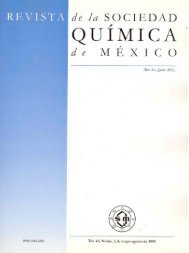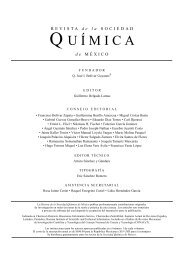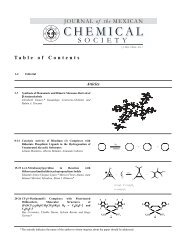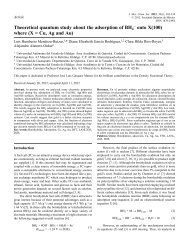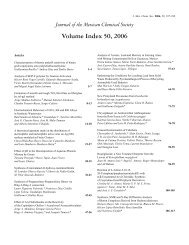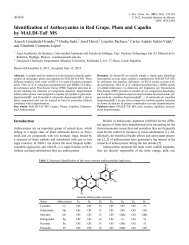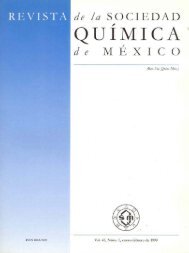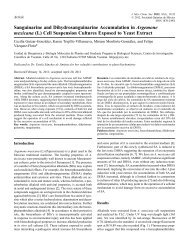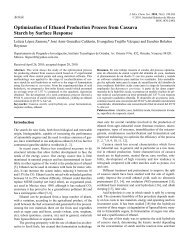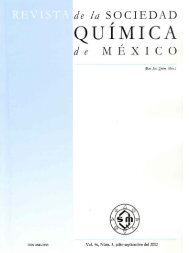SMQ-V047 N-002_ligas_size.pdf - Journal of the Mexican Chemical ...
SMQ-V047 N-002_ligas_size.pdf - Journal of the Mexican Chemical ...
SMQ-V047 N-002_ligas_size.pdf - Journal of the Mexican Chemical ...
Create successful ePaper yourself
Turn your PDF publications into a flip-book with our unique Google optimized e-Paper software.
New Eremophilanoids from <strong>the</strong> Roots <strong>of</strong> Psacalium radulifolium. Hypoglycemic, antihyperglycemic and anti-oxidant evaluations 163<br />
O<br />
HO<br />
OCH 3<br />
CH=O<br />
O<br />
OAc<br />
13 Radulifolin E<br />
O<br />
O<br />
O<br />
O<br />
O<br />
O<br />
O<br />
HO<br />
HO<br />
OCH 3<br />
O<br />
OH<br />
O<br />
tial vecinity for <strong>the</strong> carbinolic hydrogens <strong>of</strong> <strong>the</strong> β-D-glucopyranose<br />
(δ 3.78 – δ 3.01), which correlated with <strong>the</strong> corresponding<br />
signals at δ 74.78 (C-2’), 77.65 (C-3’), 71.64 (C-4’), 77.60 (C-<br />
5’), 62.97 (C-6’) in <strong>the</strong> HMQC spectrum. The crosspeaks in<br />
<strong>the</strong> HMBC spectrum between H-3 (δ 4.03) and H-2’ (δ 3.01)<br />
with C-1’ (δ 102.71) confirmed that <strong>the</strong> glucopyranose was<br />
bound to C-3 <strong>of</strong> <strong>the</strong> modifoed eremophilane. NOESY interactions<br />
between H-1’ and H-3, and between H-3 and H-4, confirmed<br />
<strong>the</strong> stereochemical assignments. Similar crosspeaks<br />
were observed for 15, and <strong>the</strong>refore, <strong>the</strong> difference between <strong>the</strong><br />
two substances was in <strong>the</strong> aglycon fragment. The stereochemistry<br />
at C-6 was deduced by comparing <strong>the</strong> 1 H NMR data <strong>of</strong> 14<br />
and 15 with those <strong>of</strong> 2 and 3 [7d]. Specifically, <strong>the</strong> downfield<br />
shift <strong>of</strong> H-4 in 14 (δ 3.37) with respect to that <strong>of</strong> H-4 in 15 (δ<br />
3.18) was in agreement with <strong>the</strong> α- and β- orientation <strong>of</strong> <strong>the</strong><br />
hydroxyl groups, respectively [16].<br />
The methanol extract obtained directly from <strong>the</strong> roots <strong>of</strong><br />
P. radulifolium was evaluated as hypoglucemic agent in normoglycemic<br />
rats, following <strong>the</strong> standard procedures [17], and<br />
<strong>the</strong> results are shown in Table 3. This residue showed significant<br />
decrease <strong>of</strong> blood glucose concentration (p < 0.05) at 7 h<br />
using several doses (30, 100 and 300 mg/kg), without returning<br />
to <strong>the</strong> basal blood glucose level. The effect <strong>of</strong> <strong>the</strong> hypoglycemic<br />
model drug is also included (glybenclamide, 10<br />
mg/kg). Cacalol (1), The mixture <strong>of</strong> 2 + 3, O-methyl-1,2-<br />
dehydrocacalol (8), and decompostin (10) did not display significant<br />
hypoglycemic activity at doses <strong>of</strong> 3.1, 10 and 31<br />
mg/kg.<br />
The antihyperglycemic effect <strong>of</strong> <strong>the</strong> methanol extract was<br />
also tested at <strong>the</strong> same doses using male diabetic Wistar rats,<br />
OH<br />
O<br />
O<br />
R 1 R 2<br />
R 1 R 2<br />
14 CH 3 OH Radulifolin F<br />
15 OH CH 3 Epi-radulifolin F<br />
OCH 3<br />
CH=O<br />
16 Maturinone 17 Acetylmaturine<br />
18 Dimaturine<br />
OH<br />
O<br />
O<br />
O<br />
R 1<br />
R 2<br />
O<br />
OAc<br />
R 1 R 2<br />
19 CH 3 OH Hydroxycacalolide<br />
20 OH CH 3 Epi-hydroxycacalolide<br />
diabetized via streptozotocin injection, following <strong>the</strong> standard<br />
procedures. The results obtained indicated that this residue did<br />
noy display significant antihyperglycemic effect in comparison<br />
with <strong>the</strong> model drug.<br />
It has been proposed that <strong>the</strong> anti-oxidant activity may<br />
play a role in <strong>the</strong> antihyperglycemic and hipoglycemic activities<br />
[18], and some reactive oxygen species (superoxide anion,<br />
hydrogen peroxide and hydroxyl fee radical) are involved in<br />
<strong>the</strong> physiology <strong>of</strong> several diseases, including diabetes [19].<br />
Therefore, <strong>the</strong> antioxidant activity <strong>of</strong> some isolated compounds<br />
(cacalol (1), <strong>the</strong> mixture <strong>of</strong> cacalone and epi cacalone<br />
(2 + 3), radulifolin C (7), neoadenostylone (11), radulifolin D<br />
(12) and radulifolin F (14)) was evaluated via <strong>the</strong> interaction<br />
with <strong>the</strong> stable free radical DPPH, following <strong>the</strong> procedures<br />
described in <strong>the</strong> experimental section. The results are included<br />
in Table 4, and <strong>the</strong>y showed that only cacalol (1) exhibited<br />
significant activity, in agreement with previous reports [20].<br />
It is interesting to note that some pure secondary metabolites<br />
did not display hypoglicemic effect, while <strong>the</strong> activity <strong>the</strong><br />
methanolic extract <strong>of</strong> <strong>the</strong> roots <strong>of</strong> P. radulifolium was evident.<br />
Although <strong>the</strong> mechanism <strong>of</strong> action <strong>of</strong> <strong>the</strong> eremophilanes, modified<br />
eremophilanes or o<strong>the</strong>r natural products [21] in changing<br />
<strong>the</strong> blood glucose levels remains unknown, <strong>the</strong> described<br />
results suggest that <strong>the</strong>re is some correlation with <strong>the</strong> ethnomedical<br />
use <strong>of</strong> <strong>the</strong> plant as antidiabetic agent. However, this<br />
plant, as all <strong>the</strong> plants used in traditional medicine, should not<br />
be used until safety studies are completed.<br />
Experimental Section<br />
General Experimental Procedures. Melting points are<br />
uncorrected. The 1 H and 13 C NMR spectra were recorded on a<br />
Varian Unity Plus-500 instrument, and <strong>the</strong> chemical shifts are<br />
expressed in parts per million (δ) relative to tetramethylsilane.<br />
Infrared spectra were recorded with a Nicolet Magna IR TM<br />
750 and Perkin Elmer 283B instruments. MS data were<br />
recorded with a JEOL JMS-AX 505 HA mass spectrometer.<br />
Electron impact mass spectra were obtained at 70 eV ionization<br />
energy. Vacuum chromatography was performed on<br />
Merck Kieselgel 60 (0.040-0.863 mm). TLC analyses were<br />
performed on TLC plates with Si gel 60 F 254 (Merck) or ALU-<br />
GRAM ® SIL G/UV 254 silica gel plates. The compounds were<br />
detected by <strong>the</strong>ir absorbance under UV 254 and UV 366 , or with<br />
a charring solution (12 g <strong>of</strong> ceric ammonium sulfate dihydrate,<br />
22.2 mL <strong>of</strong> concentrated H 2 SO 4 and 350 g <strong>of</strong> ice).<br />
Solvents were distilled prior to use.<br />
Plant material. The roots <strong>of</strong> P. radulifolium (HBK) H. Rob.<br />
& Brettell were collected in San Luis Potosí in 1995. Plant<br />
material was identified by Dr. Robert Bye and M. Sc.<br />
Edelmira Linares from <strong>the</strong> Instituto de Biología de la UNAM.<br />
The voucher Bye & Linares 2<strong>002</strong>8 was deposited in <strong>the</strong><br />
Ethnobotanical Collection, and <strong>the</strong> voucher Bye & Linares<br />
20149 was deposited in <strong>the</strong> National Herbarium, <strong>of</strong> <strong>the</strong><br />
Instituto de Biología de la UNAM.




